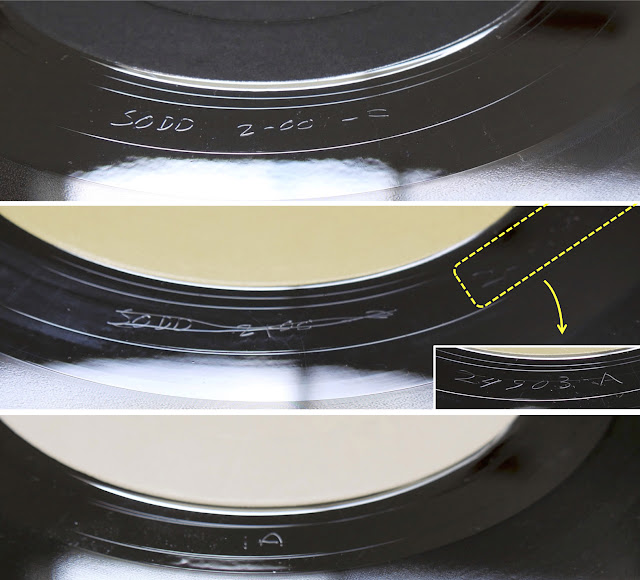 |
| The first half from a dozen line up of the Singer's Original Double Disks label releases (SODD 000 to 012) is shown. This includes two early Springsteen bootlegs from the mid-1970s, of which the SODD 006 title has two typos (Flat Tops And Pin Drops; see 5/10/2018). Taken from the slick insert of Beatles' SECOND TO NONE (SODD 009). |
Quoted from BOOTLEG: The Secret History Of The Other Recording Industry, Clinton Heyin, 1996, St. Martin's Griffin, NY.
Having stayed only between October 1974 and Mach 1975 before returning to Israel, Suki Lahav (1951—) was probably the most enigmatic and effective player in the early period of the E Street combo. As briefly described in the citation above, her contribution as a violinist/vocalist was indispensable for the stunning live arrangement and performance of new songs (Incident On 57th Street, 4th Of July, Asbury Park (Sandy), and New York City Serenade) from the then-latest album, THE WILD, THE INNOCENT & THE E STREET SHUFFLE, breathtaking cover repertoires (Spanish Harlem and I Want You), and then-unreleased BORN TO RUN tracks (Jungleland and Wings For Wheels). However, to the best of my knowledge, there were only two bootlegged concerts featuring this female talent in the vinyl era, one from the above-mentioned Main Point, Bryn Mawr, PA (February 5, 1975) and another from Memorial Chapel Concert Hall, Union College, Schenectady, NY (October 19, 1974).
 |
| My collection includes eight "SODD" slick-cover editions (three white, two orange, two blue, and one brown) and two "TAKRL" reissue versions (white or green/yellow printed sleeve). In addition, I own two more SODD 001 copies (white insert, not shown) that actually contain two discs from SODD 006 capturing the 1975 Roxy show aired on KWEST-FM (October 17; see 5/10/2018). |
As we all know, YOU CAN TRUST YOUR CAR TO THE MAN WHO WEARS THE STAR (SODD 001) is such a famous bootleg that I believe you don't need the introduction of this all-time classic title. Sourced from an FM radio broadcast by Philly's rock station WMMR of the benefit concert, this double LP was an artifact by Ken Douglas, one of the two pioneers of rock-genre bootlegs. The original was released from West Coat, probably in 1976, with an orange or white slick insert specifically designed for the Singer's Original Double Disks (SODD) series (see the above citation and 5/10/2018).
However, there was no "SODD" indication on the record labels. Instead, most early copies carried labels on the wax printing "World Records" or "Worlds Records" on a black or white background, which was in fact common to this dozen bootleg series. In addition, there was another label variant, SPINDIZZIE, which was relatively minor compared with World/Worlds Records-label copies. I've seen that SPINDIZZIE copies always came with the brownish-SODD insert cover. Interestingly, the diameter of the stamper ring greatly differs between SPINDIZZIE and World/Worlds Records labels (see the images immediately above). So, the two label variants were most probably pressed at different record plants, even though the same stampers were used for both based on the dead-wax matrix inscriptions (i.e., All are SODD 2-001-A/B/C/D; for SIDE ONE, see the upper image on the left).
Then, it was repressed in 1978 as part of The Amazing Kornyfone Record Label (TAKRL) series, the main bootleg label run by Douglas back then, which came in a printed sleeve rather than a cheap slick-insert cover, with the catalog number (TAKRL 24903) printed on the back. Accordingly, the original matrix inscriptions were crossed out, and the above number was hand-etched on each run-off groove space (24903-A/B/C/D; compare the upper and middle images above). The record labels were also changed to other kinds, such as plain pale-yellow TAKRL labels (printing a side indication only; see the label images above) or Monique D’Ozo labels, the most often seen examples (BTW, Monique D'Ozo is a real female person's name; read this entry on The Amazing Kornyfone Label blog). As well known, Douglas used all the unofficial labels mentioned above (and others) for his various bootleg releases.
The TAKRL reissue has been pirated or counterfeited many times, including the green/yellow picture-disc edition (Disc 2 only). These copies were usually inscribed with different matrix numbers than the two aforementioned (for example, "1A" on Disc One; see the bottom picture of the above dead-wax images). Such a pirate copy was one of the first three bootlegs I took the plunge and bought back in 1981 when I was a high-school boy (8/14/2015, 8/16/2015, and 9/2/2015).
— To be continued to Part 2.



No comments :
Post a Comment